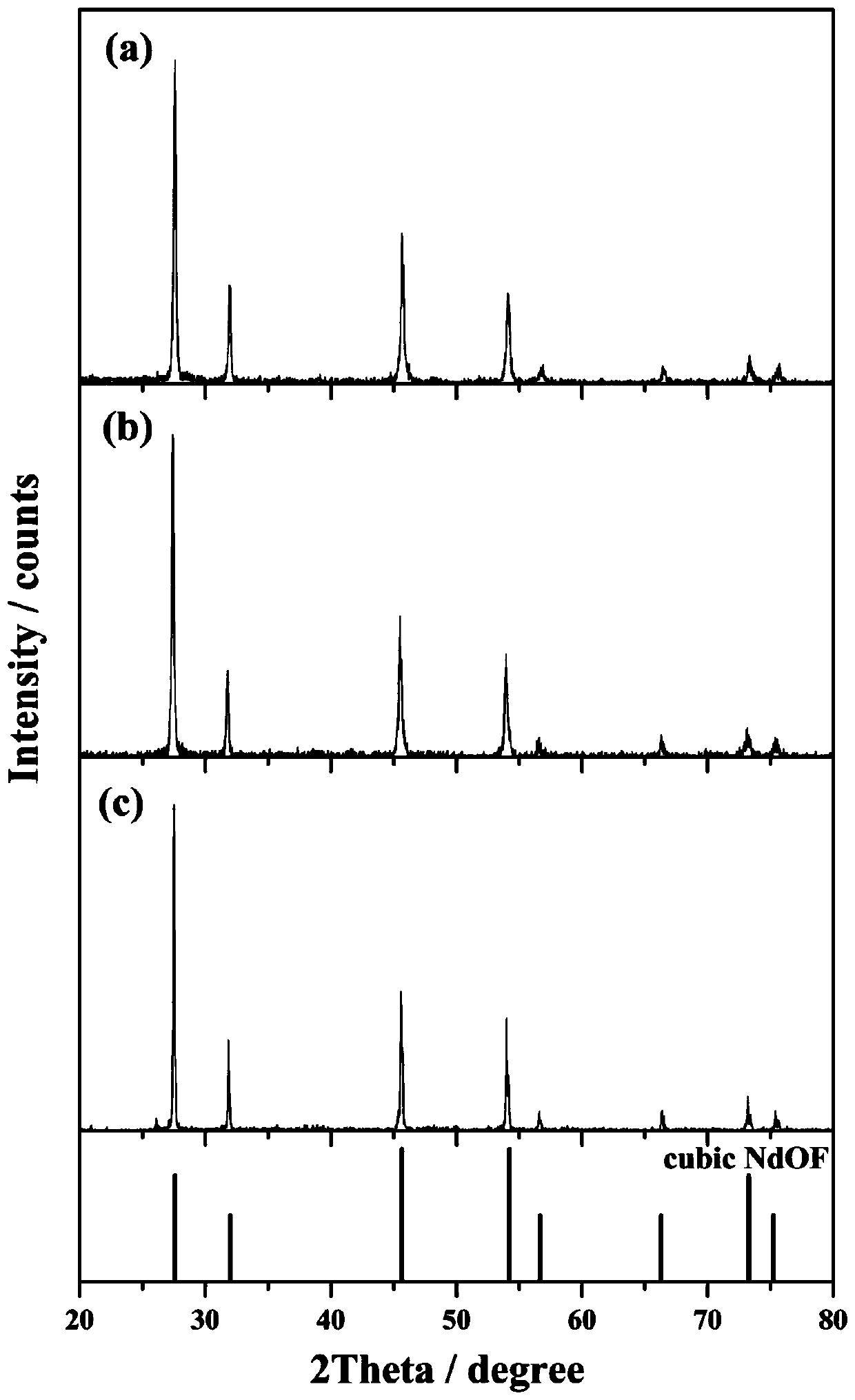Molten salt synthesis method of rare earth oxyfluoride with cubic crystal form
A technology of rare earth oxides and synthesis methods, which is applied in the direction of rare earth metal halide oxides, rare earth metal compounds, rare earth metal halides, etc., can solve the problems of difficult operation and inapplicability of large-quality samples, and reduce production costs, The synthesis conditions are not harsh and the reaction rate is fast
- Summary
- Abstract
- Description
- Claims
- Application Information
AI Technical Summary
Problems solved by technology
Method used
Image
Examples
Embodiment 1
[0045] This embodiment provides a method for synthesizing a molten salt with a cubic rare earth oxyfluoride, comprising the following steps:
[0046] Lithium fluoride, calcium fluoride, neodymium fluoride, and neodymium oxide were uniformly mixed according to the molar ratio of 4:1:3.6:3.6, and placed in a graphite crucible. Then put the graphite crucible into a box-type resistance furnace, control the temperature at 850° C., keep the temperature for 10 minutes, and then cool down with the furnace to obtain the product.
[0047] Result verification: the obtained powder is subjected to X-ray diffractometer (XRD) measurement, and after comparing the obtained X-ray diffraction pattern with the PDF card, it is determined that the generated powder is a cubic NdOF powder, and the result is as follows figure 1 as shown, figure 1 (a) is the X-ray diffraction pattern after comparison of neodymium oxyfluoride and PDF card in Example 1.
Embodiment 2
[0049] This embodiment provides a method for synthesizing a molten salt with a cubic rare earth oxyfluoride, comprising the following steps:
[0050] Lithium fluoride, potassium fluoride, neodymium fluoride, and neodymium oxide were uniformly mixed according to the molar ratio of 1:1:1:1, and placed in a graphite crucible. Then put the graphite crucible into a box-type resistance furnace, control the temperature at 900°C, keep the temperature for 20 minutes, and then cool down with the furnace to obtain the product.
[0051]Result verification: the obtained powder is subjected to X-ray diffractometer (XRD) measurement, and after comparing the obtained X-ray diffraction pattern with the PDF card, it is determined that the generated powder is a cubic NdOF powder, and the result is as follows figure 1 as shown, figure 1 (b) is the X-ray diffraction pattern after comparing the neodymium oxyfluoride and the PDF card in Example 2.
Embodiment 3
[0053] This embodiment provides a method for synthesizing a molten salt with a cubic rare earth oxyfluoride, comprising the following steps:
[0054] Lithium fluoride, sodium fluoride, neodymium fluoride, and neodymium oxide were uniformly mixed according to the molar ratio of 3:2:2:2, and placed in a graphite crucible. Then put the graphite crucible into a box-type resistance furnace, control the temperature at 800° C., keep the temperature for 10 minutes, and then cool down with the furnace to obtain the product.
[0055] Result verification: the obtained powder is subjected to X-ray diffractometer (XRD) measurement, and after comparing the obtained X-ray diffraction pattern with the PDF card, it is determined that the generated powder is a cubic NdOF powder, and the result is as follows figure 1 as shown, figure 1 (c) is the X-ray diffraction pattern after comparison between neodymium oxyfluoride and PDF card in Example 1.
[0056] figure 1 The analysis results in (a)-(c...
PUM
 Login to View More
Login to View More Abstract
Description
Claims
Application Information
 Login to View More
Login to View More - R&D
- Intellectual Property
- Life Sciences
- Materials
- Tech Scout
- Unparalleled Data Quality
- Higher Quality Content
- 60% Fewer Hallucinations
Browse by: Latest US Patents, China's latest patents, Technical Efficacy Thesaurus, Application Domain, Technology Topic, Popular Technical Reports.
© 2025 PatSnap. All rights reserved.Legal|Privacy policy|Modern Slavery Act Transparency Statement|Sitemap|About US| Contact US: help@patsnap.com


